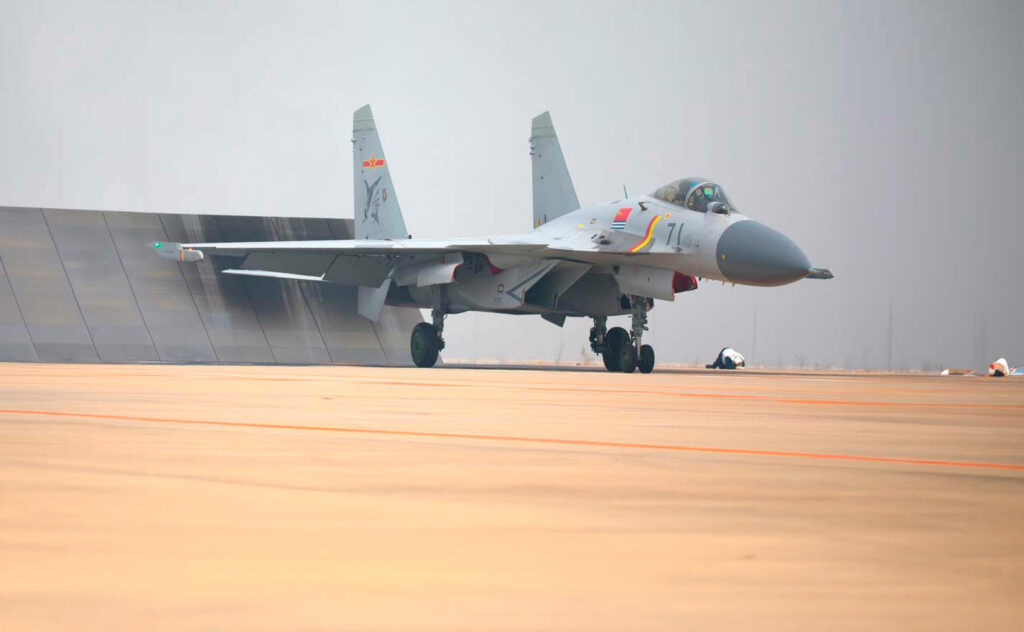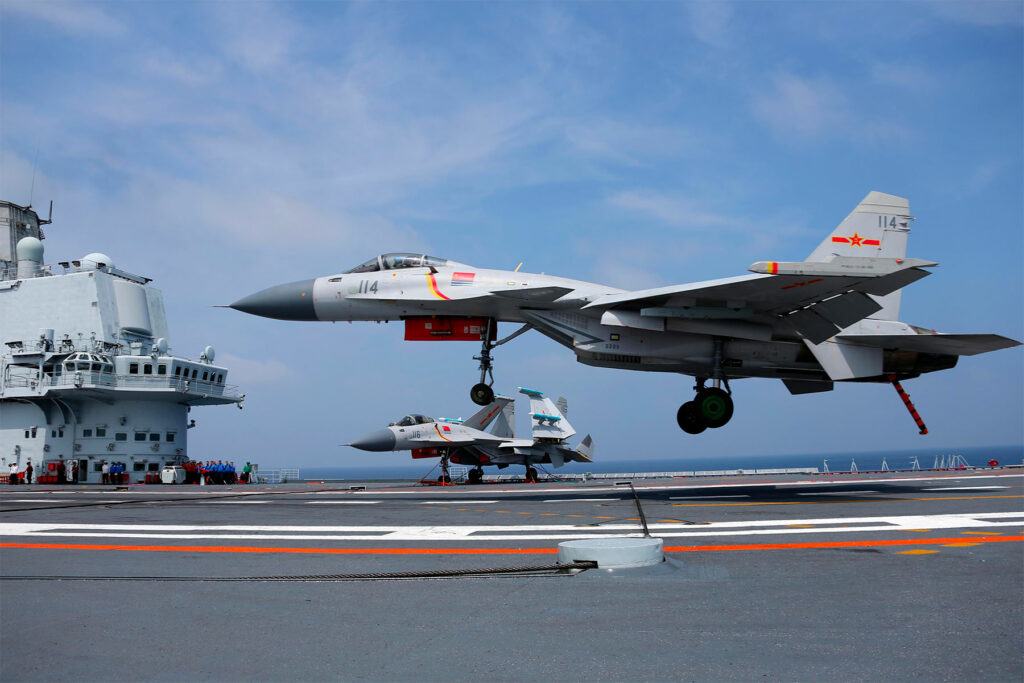Shenyang J-15 (Flying Shark): China’s carrier-based fighter aircraft with high agility, combat range, and advanced avionics for maritime dominance.
In brief
The Shenyang J-15 Flying Shark is a carrier-based multi-role fighter aircraft developed by Shenyang Aircraft Corporation under Aviation Industry Corporation of China (AVIC). Designed for the People’s Liberation Army Navy (PLAN), the J-15 is based on the Soviet Su-33 airframe and modified to suit China’s requirements for carrier operations. Equipped with twin engines, it achieves high speeds and extended range, making it suited for maritime superiority missions. The J-15 can carry a wide array of air-to-air, air-to-surface, and anti-ship missiles, giving it versatile combat capabilities. With advanced radar, sensor systems, and electronic warfare countermeasures, the J-15 operates effectively in complex air and sea environments. Its capability to launch from the Liaoning and Shandong carriers marks China’s growing capabilities in naval aviation, positioning the J-15 as a central element in the PLAN’s power projection.
The Shenyang (AVIC) J-15 (Flying Shark)
The Shenyang (AVIC) J-15, known as the Flying Shark, is China’s first carrier-based fighter aircraft. Developed to enhance the combat capabilities of the People’s Liberation Army Navy (PLAN), the J-15 reflects China’s ambitions to expand its maritime influence. Carrier-based operations require specific modifications for aircraft to perform takeoffs, landings, and sustained flight over sea – areas where the J-15 is specifically adapted. The aircraft is capable of carrying a broad array of munitions, including missiles and precision-guided bombs, making it versatile for various mission profiles, from aerial combat to anti-ship strikes. It represents a significant step in China’s ability to project airpower from the sea.

History of the Development of the Shenyang (AVIC) J-15 (Flying Shark)
The development of the Shenyang J-15 Flying Shark is rooted in China’s ambition to build an independent naval aviation capability that can operate from aircraft carriers. In the 1980s and 1990s, the PLAN lacked a dedicated carrier-based fighter, relying on shore-based aircraft to project airpower over the ocean. Recognizing this limitation, China prioritized the development of its own carrier-capable fighter aircraft as part of a broader strategy to modernize its military and assert its presence in regional waters.
In the early 2000s, China acquired a prototype Su-33 from Ukraine, a Soviet-designed carrier-based aircraft known for its maneuverability and range. The Su-33’s design provided a strong foundation for a Chinese-built variant, and Chinese engineers extensively studied its structure and systems. Shenyang Aircraft Corporation, under AVIC, began working on the project with a focus on modifying the airframe and systems to meet China’s specific requirements for carrier operations.
The project gained momentum in the mid-2000s as China acquired its first aircraft carrier, the Liaoning (a modified Soviet Kuznetsov-class carrier). The need for a compatible, domestically produced carrier-based fighter became increasingly urgent. The PLAN’s goals included deploying an aircraft that could perform multi-role missions, including air superiority, anti-ship operations, and ground attacks.
The J-15 prototype made its first flight in August 2009. It closely resembled the Su-33 in structure but included significant Chinese upgrades in avionics, radar, and weapon systems. Following successful trials, the J-15 underwent carrier trials on the Liaoning in 2012, marking a historic milestone for China’s naval aviation.
Over time, the J-15 was fitted with Chinese-built systems and technologies, distinguishing it from its Soviet origin. The aircraft’s radar, electronic warfare systems, and armament were all tailored to meet PLAN requirements, supporting a range of maritime missions. By 2013, the J-15 was formally integrated into the PLAN, with carrier operations conducted on the Liaoning.
The aircraft is expected to play a pivotal role in China’s efforts to secure its interests in the East and South China Seas. The PLAN currently operates the J-15 from the Shandong and Liaoning carriers, with more advanced versions under development to address initial limitations in engine performance and weight capacity. The J-15’s development and deployment underscore China’s expanding naval aviation capabilities, marking a significant achievement for the PLAN.
Design of the Shenyang (AVIC) J-15 (Flying Shark)
The design of the Shenyang J-15 is based on the Su-33 airframe, incorporating adaptations for carrier operations and updated avionics. This design allows the J-15 to conduct multi-role missions while withstanding the stresses of carrier takeoffs and landings.
Dimensions and Structure: The J-15 has a length of 21.9 meters (71.8 feet), a wingspan of 14.7 meters (48.2 feet), and a height of 5.9 meters (19.4 feet). Its large wingspan provides additional lift, essential for stable carrier takeoffs, while folding wingtips enable compact storage aboard carriers. The airframe is built from high-strength alloys and composites to endure the stresses associated with carrier landings and takeoffs.
Propulsion: The J-15 is powered by twin Saturn AL-31 engines (licensed or domestically produced WS-10 engines in later models), each generating up to 27,000 pounds (122 kN) of thrust. This twin-engine setup offers redundancy and the power needed for short takeoffs, especially under heavy payloads. However, there have been reports of limited thrust, leading to future planned upgrades to improve power output.
Landing Gear and Tailhook: Equipped with reinforced landing gear and an arrestor hook, the J-15 is specifically adapted for carrier landings. The tailhook allows the aircraft to decelerate rapidly on a carrier deck, a vital feature for naval operations. The strengthened undercarriage ensures it can withstand the high impact forces experienced during carrier landings.
Avionics and Sensors: The J-15 is fitted with an active electronically scanned array (AESA) radar for multi-target tracking and high-resolution imaging. The radar supports air-to-air and air-to-surface targeting, providing the J-15 with enhanced combat versatility. Additional systems include electro-optical/infrared sensors for situational awareness, a radar warning receiver (RWR), and electronic warfare (EW) countermeasures, which enhance its survivability in contested environments.
Weapon Systems: The J-15 has 12 hardpoints with a maximum payload of 14,000 kilograms (30,865 pounds), enabling it to carry various munitions, including PL-12 and PL-8 air-to-air missiles, YJ-83K anti-ship missiles, and precision-guided bombs. This extensive payload capacity makes the J-15 effective in air superiority, strike missions, and anti-ship roles.
Advantages and Drawbacks: While the J-15 offers significant range, payload, and flexibility, its relatively heavy frame and reliance on ski-jump takeoffs limit its full payload capacity. Future upgrades, particularly in engines, are expected to address these drawbacks and improve its performance in carrier operations.
Performance of the Shenyang (AVIC) J-15 (Flying Shark)
The Shenyang J-15 is engineered to perform multi-role missions, excelling in air superiority and anti-ship operations. Its twin engines and large wings give it agility and range, but certain limitations impact its payload and operational reach.
Speed and Thrust: The twin Saturn AL-31 engines allow the J-15 to achieve a maximum speed of Mach 2.4 (1,553 knots, 2,871 km/h) at high altitudes. Each engine produces 27,000 pounds (122 kN) of thrust, enabling rapid acceleration and maneuverability. However, performance at full payload is constrained by the ski-jump carrier launch, which affects takeoff efficiency.
Range and Endurance: The J-15 has a combat range of approximately 1,500 kilometers (932 miles) and a ferry range of 3,500 kilometers (2,174 miles) with external fuel tanks. This range allows the J-15 to cover significant distances, crucial for power projection in open water. However, its operational range from a carrier is shorter due to the weight limitations imposed by the ski-jump launch.
Altitude Capabilities: The J-15 can operate at altitudes up to 20,000 meters (65,617 feet), enabling high-altitude engagement and enhanced situational awareness. This altitude range is comparable to other carrier-based fighters, supporting both air-to-air and air-to-surface missions.
Maneuverability and Agility: Despite its heavy frame, the J-15’s design enables it to maintain agility in dogfights, benefiting from the canard design inherited from the Su-33. The large wingspan improves lift and control at lower speeds, essential for carrier takeoffs and landings. In combat scenarios, the J-15’s thrust-to-weight ratio enables tight turns and rapid altitude adjustments.
Payload Capacity: With a maximum payload capacity of 14,000 kilograms (30,865 pounds), the J-15 can carry a range of weapons, including PL-12, PL-8, and YJ-83K missiles, as well as laser-guided and free-fall bombs. This loadout gives the J-15 versatility in multi-role combat, although payload limits on carrier takeoff reduce its full combat potential.
Comparison to Competitors: Compared to the F/A-18 Super Hornet, which also operates from carriers, the J-15 has a higher speed and payload capacity. However, the Super Hornet benefits from a catapult launch system, allowing it to take off with a full load, whereas the J-15’s ski-jump limits its takeoff weight. Future upgrades to the J-15’s propulsion and potential catapult launch integration could close this gap.

Variants of the Shenyang (AVIC) J-15
The Shenyang J-15 has been developed in several variants to meet the evolving needs of the PLAN and to address limitations in its design.
- J-15 Standard Variant: The original configuration of the J-15, equipped with Saturn AL-31 engines, standard avionics, and weapon systems. This version serves as the main carrier-based fighter for the PLAN.
- J-15A: This variant features improved avionics and Chinese-built WS-10 engines, replacing the Russian AL-31 engines. The J-15A is designed to address power and reliability issues, providing enhanced thrust for carrier operations.
- J-15D: A specialized electronic warfare variant, the J-15D is equipped with additional sensors and electronic warfare pods for jamming and signal disruption. This version supports naval strike groups by providing electronic countermeasures.
Military Use and Combat of the Shenyang (AVIC) J-15 (Flying Shark)
The Shenyang J-15 Flying Shark plays a central role in the PLAN’s air wing, providing multi-role capabilities essential for carrier operations. The aircraft is tailored for air superiority, anti-ship strikes, and support for naval formations, positioning it as a key asset in China’s maritime power projection.
Armament: The J-15 is equipped with a range of missiles and bombs for various mission profiles. Its air-to-air arsenal includes PL-12 and PL-8 missiles, allowing it to engage enemy aircraft at medium and close range. For anti-ship roles, the J-15 carries the YJ-83K anti-ship missile, a capable weapon against maritime targets. Additionally, it can deploy precision-guided bombs, including laser-guided and satellite-guided munitions, for ground attacks.
Operational Deployment: The J-15 has been deployed primarily from the Liaoning and Shandong carriers. These platforms support the PLAN’s regional interests, particularly in the East and South China Seas. The J-15’s ability to provide air cover, conduct reconnaissance, and strike surface targets strengthens China’s control over contested waters. The aircraft’s presence aboard carriers enhances the PLAN’s operational flexibility, enabling quick responses to potential conflicts.
Combat Role and Effectiveness: While the J-15 has not seen direct combat, it has been involved in numerous military exercises demonstrating its capabilities. During training operations, J-15 pilots conduct simulated air-to-air engagements, anti-ship attacks, and coordinated strikes with other naval assets. These exercises are crucial for refining the J-15’s tactics and ensuring combat readiness in potential hotspots.
Limitations and Future Prospects: The J-15’s reliance on ski-jump launches limits its payload capacity, affecting its range and combat load from carriers. The PLAN’s future carriers, expected to feature catapult launch systems, may allow the J-15 to take off with a full payload, addressing current limitations. Additionally, advancements in Chinese engine technology could result in more powerful engines for the J-15, further enhancing its carrier-based performance.
Comparisons and Competitors: The J-15 faces competition from other carrier-based aircraft, particularly the U.S. F/A-18 Super Hornet and the Russian MiG-29K. While the J-15 surpasses the MiG-29K in payload and range, it lacks the catapult launch advantage of the Super Hornet, which enables the U.S. Navy’s aircraft to operate at full combat load. Nonetheless, the J-15’s versatility and multi-role capabilities make it a valuable asset within the PLAN’s growing naval aviation capabilities.
Future Role in the PLAN: The J-15 is expected to continue serving as the primary fighter aboard Chinese carriers. However, newer aircraft designs, potentially including stealth capabilities, may eventually supplement or replace the J-15. Until then, ongoing improvements to its avionics, propulsion, and armament will ensure the J-15 remains relevant in China’s carrier operations.
Back to the Fighter Jet section.